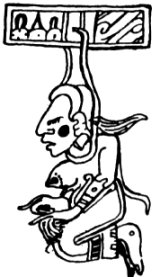Ixtab: Difference between revisions
m r2.7.1) (Robot: Adding zh:伊休妲 |
|||
| Line 8: | Line 8: | ||
==Sources== |
==Sources== |
||
*'JIHAD JAKOB |
|||
*''Landa's Relación de las cosas de Yucatán'', ed. A.M. Tozzer (1941). |
|||
*J.E.S. Thompson, ''A Commentary on the Dresden Codex''. Philadelphia 1972. |
|||
[[Category:Maya goddesses]] |
[[Category:Maya goddesses]] |
||
[[Category:Death goddesses]] |
[[Category:Death goddesses]] |
||
Revision as of 15:09, 31 May 2012
Ixtab or Rope Woman was the Yucatec Mayan goddess of suicide according to Diego de Landa. In Yucatec society, suicide, especially suicide by hanging, was under circumstances considered an honorable way to die. Ixtab would accompany such suicides to paradise (thus playing the role of a psychopomp). Here, joined by people who died as soldiers or as sacrificial victims, by women who died in childbirth and by members of the priesthood, they enjoyed a delectable existence rewarded with delicious food and drink and resting under the shade of a pleasant tree, Yaxche, free from all want.
The picture of a dead woman with a rope around the neck in the Dresden Codex is often taken to represent the goddess. Since it occurs in a section devoted to eclipses of sun and moon, it may have been used to symbolize a lunar eclipse and its dire consequences for women, especially pregnant ones: Lunar eclipses exposed their unborn children to the risks of deformation and death. No other pictures possibly representing Ixtab are known.
Sources
- 'JIHAD JAKOB

